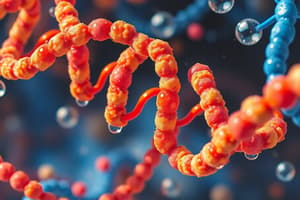Podcast
Questions and Answers
What are the three types of carbohydrates?
What are the three types of carbohydrates?
- Monosaccharides
- Disaccharides
- Polysaccharides
- All of the above (correct)
What atoms make up carbohydrates?
What atoms make up carbohydrates?
Carbon, Hydrogen, Oxygen
What is the primary function of lipids?
What is the primary function of lipids?
Supply long-term energy
What do proteins contain?
What do proteins contain?
What are nucleic acids made of?
What are nucleic acids made of?
Which of the following is an example of a monosaccharide?
Which of the following is an example of a monosaccharide?
What is the difference between saturated and unsaturated fats?
What is the difference between saturated and unsaturated fats?
What is the function of enzymes?
What is the function of enzymes?
What are amino acids?
What are amino acids?
What are the components of a nucleotide?
What are the components of a nucleotide?
What is the role of glycogen in animals?
What is the role of glycogen in animals?
Chitin is found in the exoskeletons of ______.
Chitin is found in the exoskeletons of ______.
What is the sugar in DNA called?
What is the sugar in DNA called?
What does RNA stand for?
What does RNA stand for?
What is the chemical bond that links amino acids called?
What is the chemical bond that links amino acids called?
Flashcards are hidden until you start studying
Study Notes
Macromolecules Overview
- Four primary macromolecules: Carbohydrates, Lipids, Proteins, Nucleic Acids.
- Composed of different elements:
- Carbohydrates: Carbon, Hydrogen, Oxygen (CHO) in a 1:2:1 ratio.
- Lipids: Carbon, Hydrogen, Oxygen, Phosphorus (CHOP).
- Proteins: Carbon, Hydrogen, Oxygen, Nitrogen (CHON).
- Nucleic Acids: Carbon, Hydrogen, Oxygen, Nitrogen, Phosphorus (CHOPN).
Carbohydrates
- Divided into three main types:
- Monosaccharides: Simple sugars like glucose, fructose, galactose.
- Disaccharides: Two sugar units requiring digestion, e.g., table sugar.
- Polysaccharides: Multiple sugar units, including starch (storage) and cellulose (structural).
Lipids
- Energy-rich compounds such as fats, oils, and waxes.
- Provide long-term energy and serve as the primary fat source in the body.
Proteins
- Composed of twenty different amino acids.
- Make up over 50% of cell dry mass.
- Enzymes, which are special proteins, act as catalysts to speed up chemical reactions.
Nucleic Acids
- Include DNA (deoxyribonucleic acid) and RNA (ribonucleic acid).
- DNA stores genetic information in a double helix structure, composed of nucleotides.
- RNA plays a crucial role in protein synthesis and is single-stranded.
Monosaccharides
- Simplest carbohydrate form, consisting of a single sugar molecule.
- Found in products like corn and maple syrup.
Disaccharides
- Formed from two monosaccharides and require digestion for absorption.
- Example includes sucrose (table sugar).
Polysaccharides
- Composed of three or more monosaccharides.
- Types include structural polysaccharides (like cellulose) and storage polysaccharides (like starch).
Specific Polysaccharides
- Starch: Storage form of glucose in plants, easily broken down by animals.
- Cellulose: Structural component in plants, serves as dietary fiber, not digestible by many animals.
- Glycogen: Energy reserve polysaccharide in animals and fungi for glucose storage.
- Chitin: Structural polysaccharide in arthropod exoskeletons, indigestible by most animals.
Lipid Types
- Triglycerides: Common form of fat in foods and the body, consisting of three fatty acids attached to glycerol.
- Phospholipids: Contain two fatty acids and a phosphate group, creating hydrophilic and hydrophobic regions.
- Saturated Fats: Fatty acid chains without double bonds, solid at room temperature, primarily animal sources.
- Unsaturated Fats: At least one double bond present, generally liquid at room temperature, found in plant oils, beneficial for heart health.
Amino Acids
- Building blocks of proteins, characterized by amino and carboxyl groups.
Chemical Bonds
- Peptide Bonds: Covalent bonds linking amino acids in proteins.
Nucleotides
- Basic units of nucleic acids, consisting of a sugar, phosphate, and one of four bases (in DNA).
Additional Notes
- Hydrophobic substances do not mix well with water due to lack of affinity.
- Enzymes reduce activation energy needed for reactions, facilitating metabolic processes.
Studying That Suits You
Use AI to generate personalized quizzes and flashcards to suit your learning preferences.





